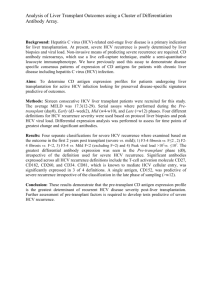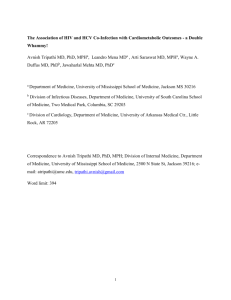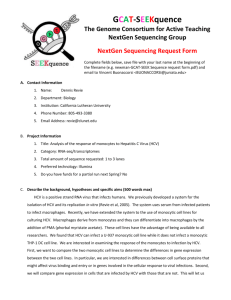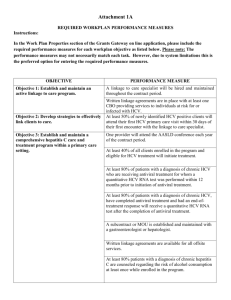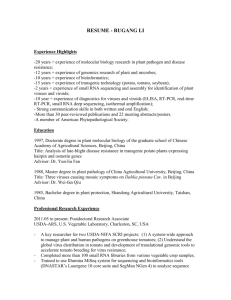Dr. Soheila Ajdary
advertisement
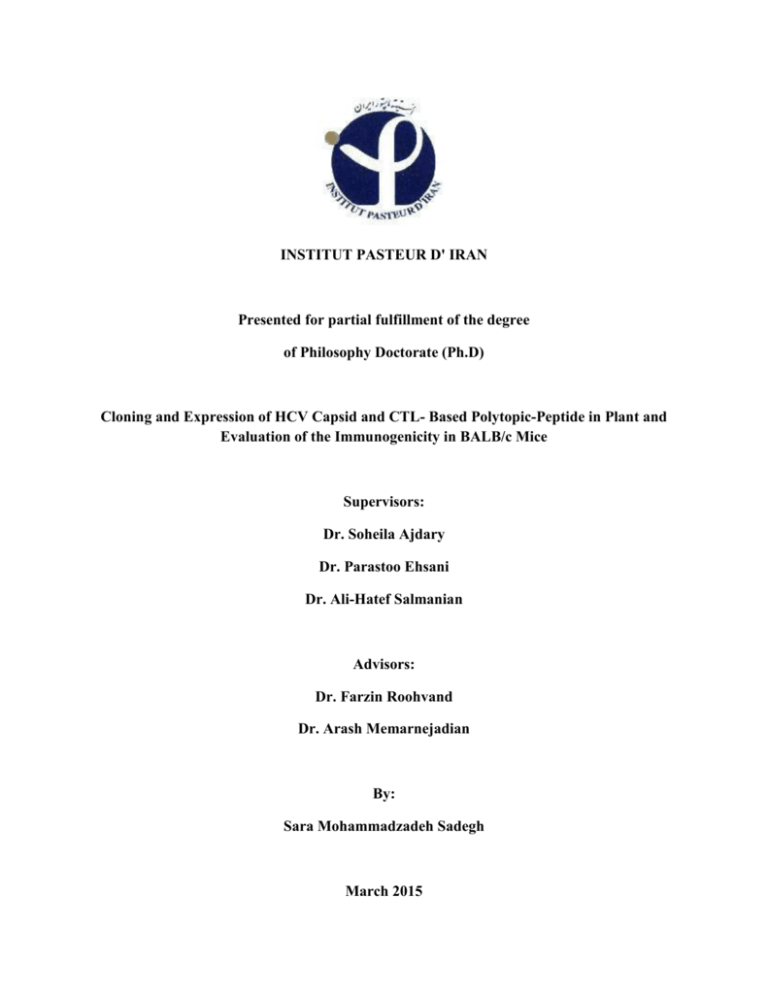
INSTITUT PASTEUR D' IRAN Presented for partial fulfillment of the degree of Philosophy Doctorate (Ph.D) Cloning and Expression of HCV Capsid and CTL- Based Polytopic-Peptide in Plant and Evaluation of the Immunogenicity in BALB/c Mice Supervisors: Dr. Soheila Ajdary Dr. Parastoo Ehsani Dr. Ali-Hatef Salmanian Advisors: Dr. Farzin Roohvand Dr. Arash Memarnejadian By: Sara Mohammadzadeh Sadegh March 2015 Abstract Hepatitis C virus (HCV) is the major cause of chronic hepatitis, which despite its 3% prevalence of the world population, no effective vaccine has been approved against until now. On the other hand, world demand for low-cost and safe vaccines has led plants to gain attention as an alternative system for most recent expression systems. In the recent study, the possibility of the expression of HCV core protein (HCVcp) and HCV polytope in fusion with HBsAg (HCVpolytope-HBsAg) as candidate antigens in designing vaccines against HCV were studied in plant expression system. Furthermore, the possibility of applying different expression platforms including transgenic expression in canola (Brassica napus L.) seeds and transient expression in tobacco (Nicotiana tabacum) leaves using classical binary and virus-based vector to produce HCVcp was evaluated. In the end, the immunogenicity of expressed HCVcp protein in canola oilseed and the effect of using oil body in immune responses were examined. In this respect, HCVcp and HCVpolytope genes were optimized for expression in the plant hosts. The designed HCVcp gene from N- to C-terminal in tandem included kozak sequences, hexahistidine (6×His)-tag peptide, HCVcp (1-122 residues), and KDEL for retention in ER. The optimized HCVpolytopic construct encoding the Kozak sequence, 6×His-tag, and HCV polytope, which was N-terminally fused with HBsAg gene, was cloned into Potato virus X (PVX-GW) vector. Additionally the optimized HCVcp was inserted into Potato virus-X (PVX) and classic pBI121-binary vectors in separate cloning reactions. The resulted recombinant plasmids (pVX-poly-HBs, pVX-core, and pBI121-core) after confirmation by restriction and sequencing analyses were transferred into Agrobacterium tumefaciens and were vacuum infiltrated into tobacco leaves. The effect of gene silencing suppressor P19 protein from TBSV was tested on expression yield of HCVcp and HCVpoly-HBsAg was also evaluated by ELISA. For transgenic expression of HCVcp in canola (Brassica napus L.) seeds, the optimized HCVcp subcloned into pBI1400 binary vector under the control of the seed specific promoter FAE1 and transformed into canola. Transgenic lines were screened and the presence of the transgene in the T0 plants was confirmed by PCR. The quantity and quality of the HCV core protein (HCVcp) in the plant were evaluated by ELISA and western blot respectively. Transgenic seeds and HCVcp purified from E. coli in combination with oil bodies were evaluated in immunogenicity studies in BALB/c mice. Results of optimization design demonstrated that the codon adaptation index (CAI) value increased to more than 85% for the genes. Sequencing results confirmed the correctness of cloning steps for constructed cassettes and the transformed Agrobacteria with the constructs were confirmed by colony-PCR. Moreover, sandwich ELISA results indicated the expression of HCVcp and HCVpoly-HBsAg and the expression level enhanced 3-5 fold in P19 coagroinfiltrated tobacco leave as well. The plant-derived HCVcp (pHCVcp) was identified by HCV-infected human sera. Western blot analysis using anti-His and specific antibodies confirmed the presence of a 15 kDa protein in seeds of T1 transgenic lines and tobacco leaves. The amount of HCV core protein expression in the seeds of transgenic lines and tobacco leaves was estimated 0.02% to 0.05% of the total soluble protein (TSP). The results of immunogenicity evaluation indicated the ability of transgenic canola seeds in inducing specific immune response against HCVcp and the effect of oil bodies on type of immune response. In these studies, mixed Th1 and Th2 responses were induced as well. The results demonstrated minute amounts of rHCVcp expressed in Canola oilseed were capable of inducing immune responses comparable to 10 fold of the same purified recombinant protein, expressed in E. coli. Considering that plant is a useful expression system for the production of vaccine antigens, the result of the present study has been able to provide useful information on development of plantbased vaccines especially in HCV studies. Key words: HCV core protein, HCVpolytope, seed specific expression, Brassica napus, Nicotiana tabacum.Transient expression, Cellular Immunity, Cytokine response, IFN-γ secreting lymphocytes,



